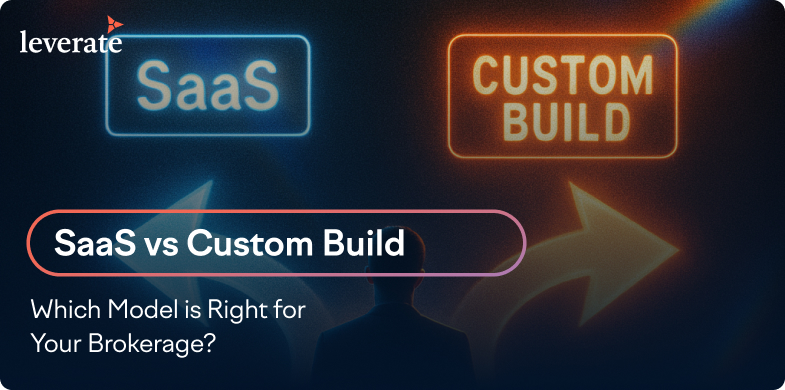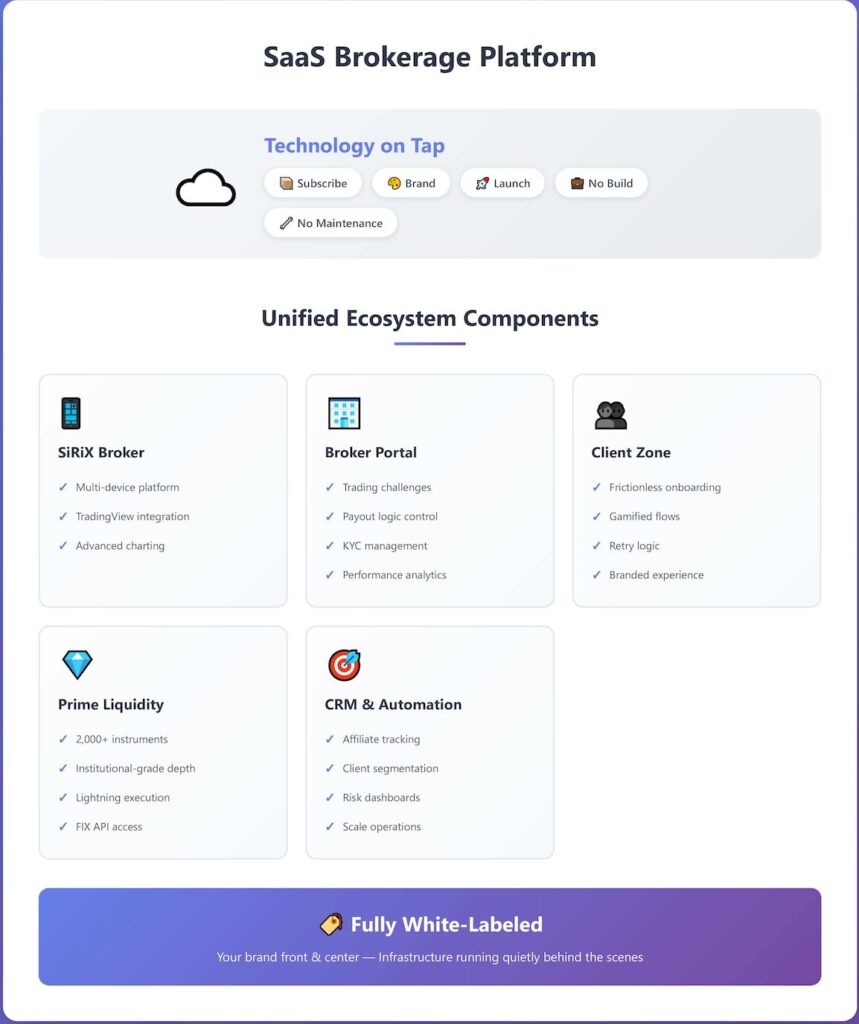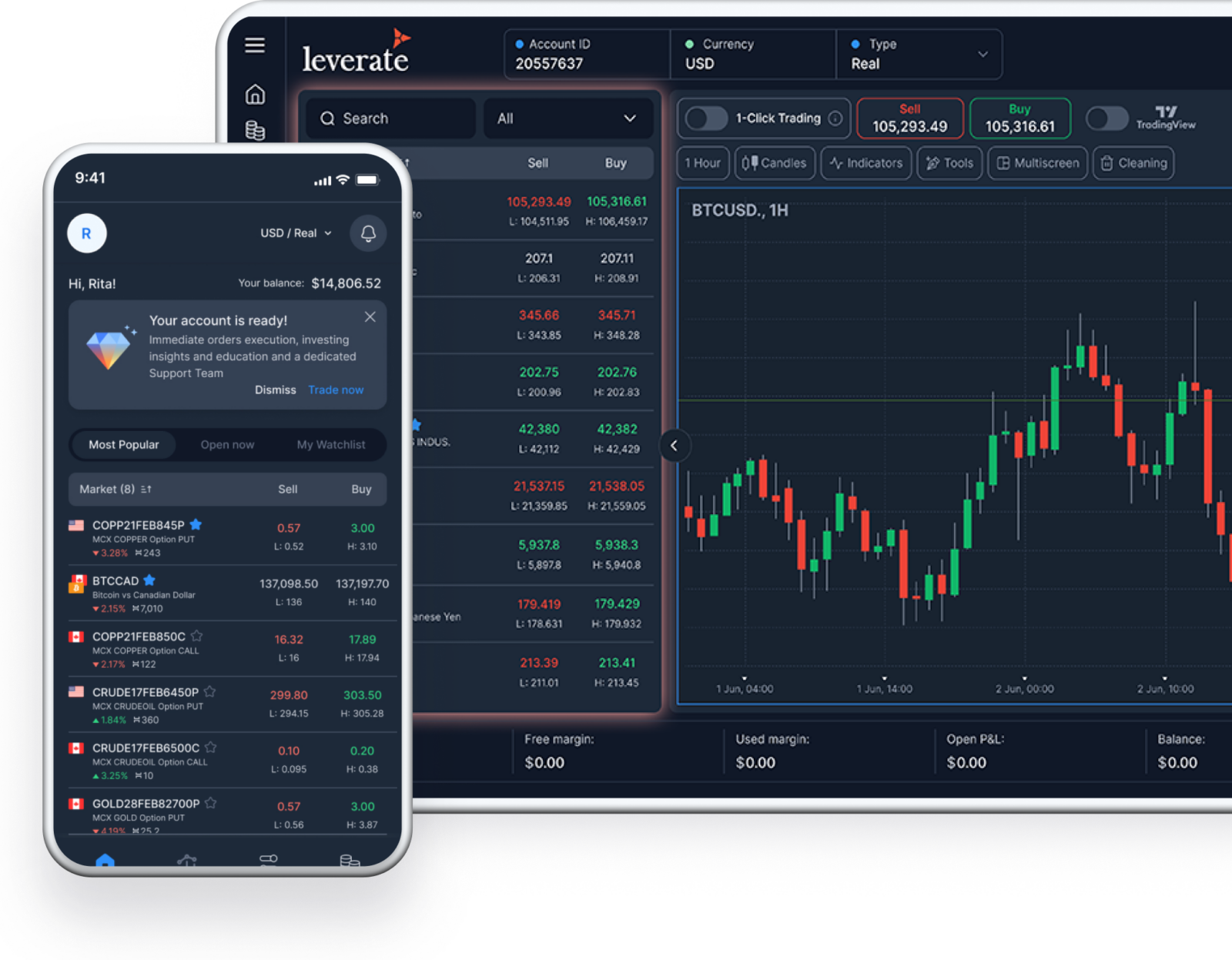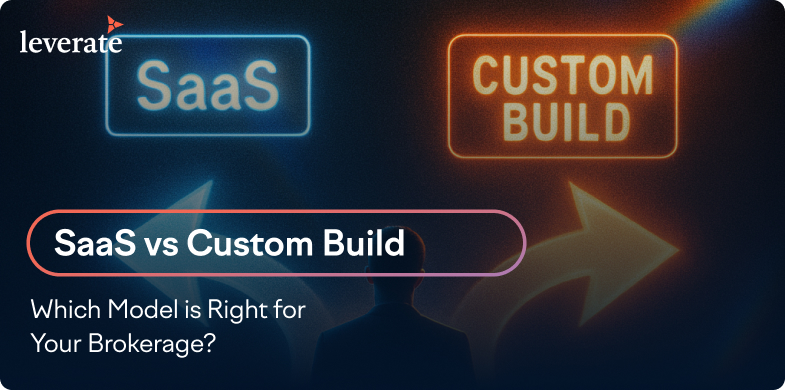
SaaS vs Custom Build: Choosing the Right Technology Model for Your Brokerage
Every brokerage reaches that moment, the fork in the road where tech dreams meet reality. One route gleams with speed, scalability, and ready-to-run systems. The other promises control, uniqueness, and ownership, but comes with heavy upkeep and longer nights.
That’s the age-old question: Should you build your own trading technology or go with a SaaS platform?
It’s not just a technical decision, it’s a strategic move that defines how fast you launch, how far you scale, and how much risk you’re willing to own. Let’s strip this debate down to its core and find out which model actually fits your brokerage future.
What Exactly Is a SaaS Brokerage Platform?
Think of SaaS as technology on tap. A SaaS platform delivers the entire trading infrastructure — from execution engines to CRMs, as a subscription service. You don’t build, host, or maintain the code. You just connect, brand it, and run your business.
With Leverate’s SaaS ecosystem, brokers and prop firms get a unified, white-labeled suite that powers the entire operation:
- SiRiX Broker – a multi-device trading platform built for brokers, now integrated with TradingView for advanced charting and analysis.
- Broker Portal – designed for prop firms, offering full control over trading challenges, payout logic, KYC stages, and trader performance analytics.
- Client Zone – frictionless onboarding, gamified user flows, retry logic, and branded client experiences.
- Leverate Prime Liquidity – deep, institutional-grade liquidity across 2,000+ instruments with lightning-fast execution and FIX API access.
- CRM & Automation Hub – built-in affiliate tracking, segmentation, risk dashboards, and CRM logic to handle clients at scale.
Each component is fully white-labeled, meaning your brand stays front and center, while Leverate keeps the machinery humming quietly beneath the hood.

What Does It Mean to Go Custom?
Building a custom brokerage platform is like designing your own airplane, powerful if done right, but risky and expensive if not.
You’ll need to either assemble a full in-house dev team or outsource to specialists. They’ll design your trading engine, CRM, KYC flow, affiliate system, back office, and reporting stack from scratch. You own the infrastructure, the architecture, and the problems.
A custom build gives you complete control, but also full accountability. Long development cycles, unpredictable costs, and heavy compliance demands are part of the deal.
Unless you have deep capital, internal tech muscle, and time to burn, the DIY route can quickly turn into a tech treadmill.
SaaS vs. Custom Build — The Real-World Breakdown
Let’s break down the differences in the areas that actually matter when you’re launching or scaling a brokerage.
1. Speed to Market: The Momentum Multiplier
SaaS: Ready to go live in weeks, not quarters. With Leverate’s stack, new brokers can launch within 30 days — complete with trading platform, CRM, and client onboarding.
Custom: Average 6–12 months of development before you even start testing. Add another few for compliance and optimization.
Verdict: When market opportunities move fast, speed is your superpower. SaaS delivers instant momentum.
2. Technical Complexity: Who Carries the Burden?
SaaS: Your provider manages the backend, uptime, patches, and security. You focus on clients; Leverate handles the code.
Custom: You’ll need a full dev team to manage uptime, push updates, monitor bugs, and maintain compatibility across devices. If one part fails, it’s your fire to put out.
Verdict: Unless you’re running a dedicated tech division, SaaS removes the complexity tax so you can focus on the business.
3. The True Cost Equation
The smartest brokers don’t ask, “What does it cost?” They ask, “How long until it pays back?”
| Expense Type | SaaS (Leverate) | Custom Build |
| Setup | Low | High (development & infra) |
| Monthly Ops | Predictable subscription | Staffing, hosting, maintenance |
| Time to Profit | Fast | Delayed |
| Scalability | Built-in | Cost rises with growth |
SaaS feels like an ongoing cost, but the total cost of ownership of a custom platform balloons over time. Developer churn, regulation changes, server upgrades, all add up fast.
Verdict: Predictability beats volatility. SaaS keeps the financial runway smooth.
4. Customization & Flexibility: The Great Misconception
There’s an old myth that SaaS equals rigidity. That’s ancient history.
SiRiX Broker gives CFD brokers deep customization of trading conditions, instruments, and branding. Meanwhile, Broker Portal empowers prop firms to design every challenge stage, payout rule, retry option, and performance metric to match their exact model.
Add localization in 30+ languages, configurable client flows, and personalized design, and you’re essentially running your own ecosystem without the coding nightmare.
Custom builds do offer total flexibility, but every tweak requires a sprint, testing, and re-deployment.
Verdict: SaaS gives you all the creative freedom, minus the technical drag.
5. Compliance & Security: The Unseen Battlefield
Financial tech lives under constant scrutiny. Compliance isn’t optional, it’s survival.
SaaS: Providers like Leverate stay in sync with regulatory frameworks (CySEC, FCA, ESMA) and maintain advanced encryption, AML logic, GDPR readiness, and data auditing. They evolve alongside global standards, so you don’t fall behind.
Custom: You’re responsible for your own compliance stack. That means designing KYC, document storage, AML reporting, and data protection from scratch. One misstep could mean penalties, client loss, or worse, reputation damage.
Verdict: SaaS provides enterprise-grade security and legal alignment without building an in-house legal tech team.
6. Integration Ecosystem: The Network Effect
Modern brokerages don’t live in isolation, they thrive on integrations.
SaaS (Leverate): Comes pre-wired with payment service providers (Payotop, CoinPayment), affiliate systems, VOIP tools like Voiso, and automation via Zapier. It’s a living network where everything already talks to everything else.
Custom: Every integration must be built, tested, secured, and maintained manually. Each new PSP or CRM update can break old connections.
Verdict: SaaS keeps your operation connected, future-proof, and stress-free.
7. Trader Retention & Feature Velocity
Markets evolve fast, your traders expect innovation even faster.
SaaS: Providers like Leverate roll out updates across all clients simultaneously, new charting tools, gamification mechanics, or social-trading enhancements. Everyone benefits instantly from constant evolution.
Custom: Every feature request requires new dev cycles. Unless you’ve got unlimited resources, innovation slows to a crawl.
Verdict: SaaS evolves while you sleep. Custom stagnates unless you keep spending.
When Custom Build Actually Makes Sense
There are rare cases where building custom is justified, but only if you’re playing on a different level.
Consider a custom route if you’re:
- A large brokerage with deep pockets and a proprietary edge you can’t replicate through SaaS.
- Building a cross-industry platform (e.g. trading + gaming, or a fintech super-app).
- Bound by internal or governmental policies that require on-premise data hosting.
For everyone else, the math favors SaaS, it’s faster, cheaper, and more resilient in a volatile industry.
Why Leverate’s SaaS Ecosystem Works Like a Growth Engine
Leverate’s ecosystem isn’t just a bundle of tools, it’s a living framework built for both brokers and prop firms, tuned for performance and growth.
Here’s how it all connects:
- SiRiX Broker: The flagship trading platform for brokers, multi-device, lightning-fast, and integrated with TradingView. It delivers a seamless experience for traders while giving brokers deep configuration options and visual control.
- Broker Portal: Purpose-built for prop firms. From challenge creation to KYC verification, payout automation to retry mechanics, every step can be customized without a single line of code.
- Client Zone: Keeps traders engaged with personalized flows, leaderboards, and intuitive dashboards.
- CRM & Automation Hub: Handles affiliate logic, client segmentation, and integrations with communication tools like Voiso, Convrs, and Zapier.
- Leverate Prime Liquidity: Institutional-grade liquidity across thousands of instruments, offering the pricing depth and execution speed brokers need to stay competitive.
Brokers and firms that switch from custom systems to Leverate consistently report higher trader retention, faster profitability, and fewer tech headaches.
The secret? Continuous iteration. While others rebuild once a year, Leverate refines continuously, every update pushing all clients forward together.

7 Strategic Questions to Clarify Your Path
If you’re torn between custom and SaaS, start here:
- Do I need to launch in under 60 days?
- Can my team handle dev, IT, and compliance simultaneously?
- Do I value stability or total control more?
- What happens if key devs leave mid-project?
- Can I afford to rebuild if the MVP fails?
- Do I want rapid iteration or slow perfection?
- Can I maintain compliance across multiple jurisdictions?
If even two of those make you hesitate, your answer is already leaning SaaS.
Build Smart, Scale Fast
Most modern brokerages don’t need to reinvent the wheel, they just need a wheel that spins faster.
SaaS platforms have evolved into living ecosystems, flexible, compliant, and constantly improving. They remove nearly 80% of the technical and regulatory friction from running a brokerage, letting founders focus on clients, growth, and strategy.
Custom builds are bold, sometimes brilliant, but often brutal. Unless you’ve got endless funding and an in-house tech army, they can weigh your business down instead of propelling it forward.
Leverate’s SaaS ecosystem gives you the best of both worlds: control without chaos, power without fragility, innovation without downtime.















